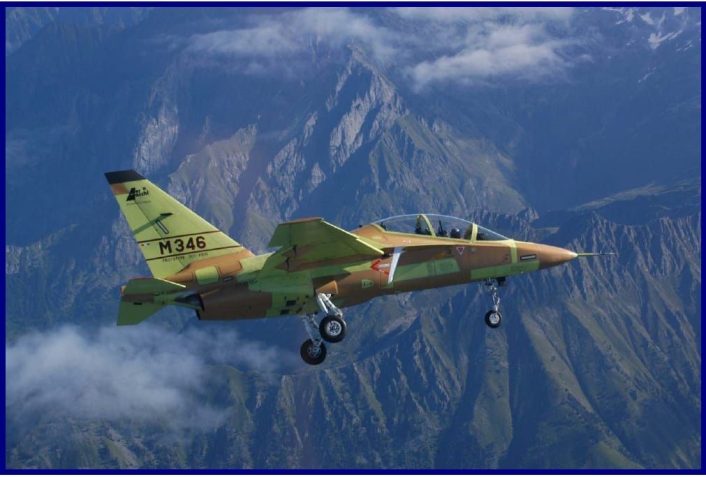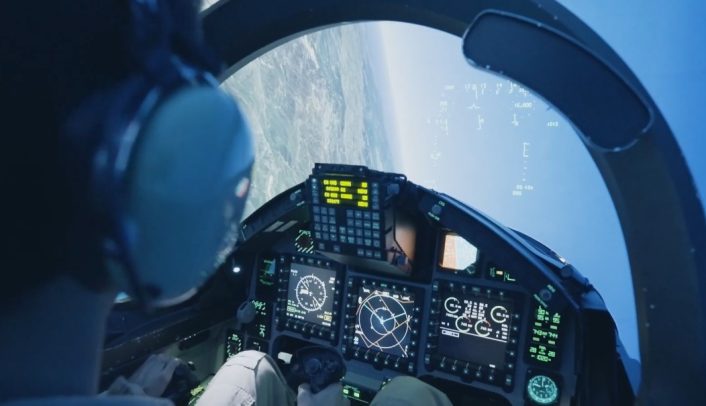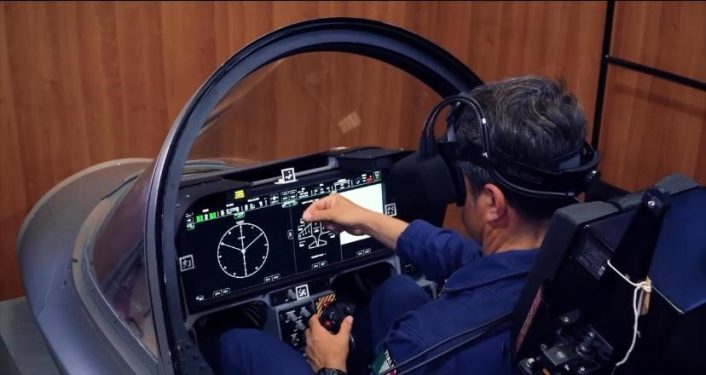On July 15, 2024, the M-346 advanced jet trainer celebrated 20 years since its first flight, and is now being further upgraded to start the next chapter of its operational life.
Jul. 15, 2024, marked the 20th anniversary of the first flight of the M-346 Master. The aircraft, considered by many as the most advanced jet trainer currently available, brought many new technologies to improve the training of future 4th and 5th gen fighter pilots, including the state-of-the-art Ground-Based Training System and the Live Virtual and Constructive (LVC) technologies.
With more than 100 aircraft on order by major international air forces, including those of Italy, Israel, Poland, Singapore, Qatar and Greece. The M-346 is also the backbone of the Italian Air Force and Leonardo’s International Flight Training School (IFTS), where pilots from nine different countries are training today, and is also being proposed as a replacement for the U.S. Navy’s T-45 fleet.
The M-346 might now be about to start a new chapter as the new aircraft of the Italian Air Force’s aerobatic team Frecce Tricolori. In fact, it is being reported that the team might unveil the M-346 in the Frecce Tricolori livery as replacement of the current MB-339PAN, which has been in use since 1982. The team was initially expected to adopt the new M-345 High Efficiency Trainer, however there is no official confirmation of this change of plans.
The M-346 background
In 1993, Aermacchi, which is now part of Leonardo, began collaborating with the Russian company Yakovlev to develop an advanced military jet trainer. This collaboration resulted in the creation of the YAK/AEM-130 Technology Demonstrator Program, which had its maiden flight in 1996.
However, in 1999, the two companies decided to end their partnership and pursue independent developments of the aircraft. Aermacchi took over the project, renaming it the M-346, after significant modifications, and retaining the commercialization rights. Yak instead went ahead with its own variant, the Yak-130.
The first M-346 prototype was introduced in 2003, achieving its first flight on July 15, 2004. The first pre-series aircraft took to the skies in July 2011, and in the same year, the M-346 reached a speed of Mach 1.15, becoming the second Italian-built aircraft to achieve this milestone. Thanks to its collaboration with the Italian Air Force, the aircraft quickly gained success, attracting the interest of many armed forces worldwide.

Let’s take a look at today’s M-346
The M-346 Advanced Jet Trainer (AJT) is a twin-engine, tandem-seat, transonic aircraft – capable of reaching supersonic speeds in a dive – produced by Leonardo Aircraft Division in Venegono, Italy. This Lead-in Fighter Trainer is engineered to provide student pilots with a state-of-the-art training environment that closely simulates the capabilities of modern combat aircraft through the use of advanced simulation of sensors and technologies.
Powered by two Honeywell F-124-GA-200 engines, each delivering 2,850 kg of thrust, the M-346 is equipped with an Auxiliary Power Unit (APU) that allows it to operate independently during startup without external support. The aircraft features a full authority fly-by-wire system, which enhances its flying characteristics and offers carefree handling to ease the pilot’s workload.
Its cockpit includes a Head-Up Display (HUD), three Multifunctional Displays (MFDs) for each pilot, a Hands-On Throttle and Stick (HOTAS) system, and a Pilot Activated Attitude Recovery System (PARS) to improve safety. Additionally, the M-346 can be fitted with an air-to-air refueling probe and can be armed with practice air-to-ground bombs and a gun pod for live fire training at the range.
It also utilizes a Helmet Mounted Display (HMD) to project tactical information, such as weapons cues, directly onto the pilot’s visor, emulating the systems found in 4th and 5th generation fighter aircraft. Among the systems that the aircraft can simulate are the radar, self-protection suite, weapons’ employment, datalinks, targeting pods.

The training suite of the M-346
Thanks to its comprehensive training suite, the M-346 has achieved the top position among advanced trainer aircraft. The Integrated Training System Solution includes an Embedded Tactical Training System (ETTS), advanced mission simulators, and a Live, Virtual, and Constructive (LVC) training environment. This system is further enhanced by academic training that utilizes Computer-Aided Instruction (CAI) and Computer-Based Training (CBT) technologies, offering a holistic and immersive training experience for pilots.
The ETTS Data Link allows the M-346 to train pilots in various operations, from air-to-air combat to air-to-ground missions. The training system can emulate various equipment, including Fire Control Radar (FCR) based on an AN/APG-68 radar usable against real and computer-generated forces (CGF), targeting pods (TGP), and active and passive electronic countermeasures.
The system can operate in a standalone mode, where simulated data is loaded before takeoff, or in a networked environment, receiving real-time information from a ground monitoring station via the aircraft’s datalink system. This setup exposes the aircraft to generated tactical scenarios with threats and targets, compelling the pilot to react to dynamic situations they may encounter during their operational career.
A noteworthy feature of the system, called Live Virtual Constructive (LVC), allows the integration of a real airplane undergoing a training sortie with a “synthetic” airplane operated by a pilot in a ground-based simulator. This drastically reduces operational costs. Simultaneously, the instructor can closely monitor the training activities from the Real Time Monitoring Station (RTMS), injecting updated threats into the scenario and acting as a Tactical Controller to support the pilots.

The M-346 as a front-line capable aircraft
In addition to its training variant, Leonardo has developed a combat-capable version of the aircraft called the M-346 FA (Fighter Attack). This version is equipped with Leonardo’s Grifo multi-mode radar, an advanced Identification Friend or Foe (IFF) system, and a Defensive Aids Sub-System (DASS).
The M-346 FA can be armed with a variety of weapons across its seven hardpoints, supporting both air-to-air and air-to-ground weapons, making it a highly adaptable and formidable asset in medium- to low-intensity combat scenarios. On request, the Fighter Attack variant can be equipped with tactical data links such as Link 16 to enhance the pilot’s tactical awareness.
Notably, the M-346 FA retains the training capabilities of the AJT variant, and can be used in a dual role. Currently employed by the Turkmenistan Air Force, this variant has also garnered interest from other nations, including Nigeria, which are keen on acquiring this advanced model.
The International Flight Training School
The Italian Air Force, in collaboration with Leonardo and CAE, is utilizing the M-346 aircraft at the International Flight Training School (IFTS) located at Decimomannu Air Force Base in Sardinia. The IFTS is a strategic partnership aimed at creating an advanced flight training center for military pilots.
The school offers a comprehensive Phase IV Advanced/Lead-In to Fighter Training (LIFT) program based on the Italian Air Force syllabus, which can be customized to meet the specific requirements of contracting partner air forces. This program allows for the efficient transfer of training tasks from Operational Conversion Units, ensuring effective pilot training.
The training process is supported by international military and civilian pilots, providing a robust and diverse training environment. The school is now an international reference for Advanced LIFT, as it has already become internationally renowned, throughout its first years of operations, as one of the most advanced and state-of-the-art flight schools.
Future upgrades
As announced on July 22, 2024, at the Farnborough International Airshow, Leonardo is developing an enhancement package for the M-346 called Block 20. This new iteration will feature an upgraded cockpit layout and enhanced training capabilities, incorporating cutting-edge technologies to further improve pilot training and operational effectiveness.
A picture from a Leonardo video reveals a cockpit layout consistent with the Block 20 modifications, showcasing a single Large Area Display (LAD) akin to the F-35’s Panoramic Cockpit Display (PCD) or the similar displays featured on new aircraft like the F-15EX, F/A-18 Block III and the Typhoon P4E. Notably, the Head-Up Display (HUD) system is absent in the picture, although Leonardo said the aircraft will use a low-profile HUD.
Both M-346 AJT (Advanced Jet Trainer) training and M-346 LFFA (Light Fighter Family of Aircraft) fighter variants will benefit from these enhancements for a wide spectrum of applications, while implying significant margin for further developments in the future. The M-346 Block 20 will also benefit from new navigation, weapon management, flight management system, IFF (Identification of Friend or Foe) transponder.
Specifically for the M-346 F variant, further critical capability enhancements include an AESA (Active Electronically Scanned Array) radar featuring fire control radar capability, integration of new weapons for both air-to-air and air-to-ground roles in addition to a built-in missile datalink. The whole Ground Based Training System (GBTS) holistic approach to training, with multi-media and classroom course, flight/mission simulation, virtual and live/constructive training, will step up to the new standard via virtual reality support and AI applications, said Leonardo.






